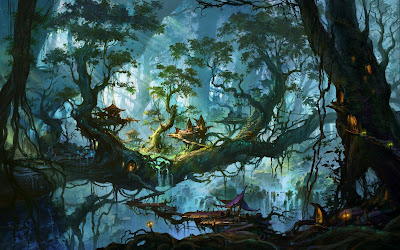Thursday, September 24, 2015
Flavorful: The Importance of Imagination
I asked fellow DM and tabletop RPG aficionado Tim Lang to share his thoughts about good game mastery, based on his many years of tabletop experience. His observations highlighted the importance of a game's flavor, the elements of imagination and creativity that mix to create a fun experience. If you want your players to really enjoy your world, this boils down to one big idea:
You want your adventure to be memorable.
There are two terms that get thrown around in RPG design circles... fluff, representing the lore and description of the game world. And crunch, meaning the rules and game mechanics that make up the system. Both are important, and should be taken in new and exciting directions whenever you run a game. The fluff should be interesting to the players, and the crunch should be fun to engage with.
Basically, if an encounter doesn't sound interesting when you relate it as an anecdote, it should be reworked until it would make a good story.
You don't want "We fought a bugbear in a forest." You at least want "Bugbear ambush at lunchtime. He was disguised as a bush and trying to steal our food." Something people will say "Hey, remember when?" about.
As Tim puts it, "If you're in a dungeon, you don't want it to be "that dungeon where we fought that guy." You want "the temple to the dead God with all the demonic sigils and the possession traps.Or the underground ruins of the machine city where the ground moved beneath us while we fought. If you're playing high fantasy, you shouldn't be afraid to use fantastic elements to spruce up otherwise mundane activities."
"Tolkien is actually a good reference for atmospheric locations. Just think of all the distinct places he's given us: Shelob's lair, the treetop settlement of Lothlorien, Smaug's monumental trove of treasure. Even before the movies, those were iconic and inspired tons of later fantasy writers."
Theme is the key. Each of those were pretty high concept without being simplistic. If you start throwing everything and the kitchen sink in it becomes too random, but if you just have one environmental gimmick it will be too basic.
Back to Tim: "That's where the environment needs to intersect with who or what is living there, and what the players are doing there. Smaug wouldn't work in a dark winding cave, and Shelob in a tower is likewise ineffective."
Even games based in real-world history can have these evocative qualities. Integrating well-researched history, cultures, and technologies into a game is another way to make things memorable and engaging.
Originality isn't everything, but transform each concept into your own.
There is nothing new under the sun, to coin a phrase. So don't worry if your idea is based off a borrowed concept or a popular trope. Just remember to make it your own. Transform the generic into the unique. Turn that magical forest into a florescent wonderland of giant mushrooms with a collective consciousness. Make the evil emperor a lich in disguise. It doesn't have to be the first time the concept has ever been thought up, as long as it is makes for a unique experience for your players.
For each person place or thing, ask yourself: What is special or unique about this? What will make it memorable?
This whole process of building an evocative setting relates to the foundations of gaming, specifically imagery and variety. Players generally don't want the game to be a droll grind in a world of the mundane. Better to keep things fresh. Mix up a recipe of fluffy, crunchy, goodness that keeps people coming back to the table for seconds. Let the game get dramatic and silly as needed.
This is a medium that is, at its core, a bunch of people shouting ideas around a table. That's why even at its most strictly regulated, there remains a certain sense of gonzo adventure. Embrace the dynamic nature of the tabletop! Let your imagination soar!
Happy Ventures!
Subscribe to:
Post Comments (Atom)



No comments:
Post a Comment